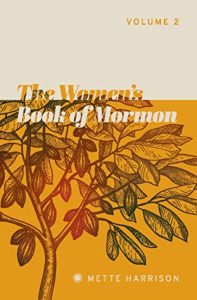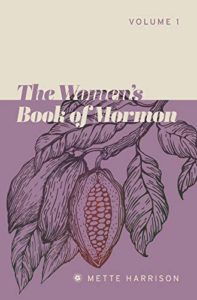 Mette Harrison previews her novel, The Women’s Book of Mormon, Volume 2, which has just been published by BCC Press.
Mette Harrison previews her novel, The Women’s Book of Mormon, Volume 2, which has just been published by BCC Press.
I have come full circle this year. The first full-length book manuscript I ever wrote was at age 14. I called it Clarence, You’re an Angel. It was a YA novel with time traveling teens going back to the Jaredite times. I wrote it enthusiastically, believing 100% in the historical reality of the book of scripture I had grown up with. I edited it and sent it out to publishers with the help of a family member who knew more about the book business. Somewhere, I still have the personalized rejection that explain Deseret Book did not publish anything that fictionalized heaven or angels, but encouraged that I send in anything else I wrote.
I never did, though I once had a book contract with Covenant that ended up going sideways over contract disputes.
I stopped attending the Mormon church in 2018. I was one of those people I think you never hear about, who didn’t “slowly” begin to lose faith. I was fully active, teaching the Sunbeams and attending every week without fail, until I decided that my conscience could not allow me to continue to attend. I had been trying to make it work, singing different words to songs to make them more feminist and wearing black to protest the exclusion policy (along with a rainbow ribbon), but it didn’t change anything and it only made me more and more of an outsider in the church that I once loved so much.
 Only months later, a friend reached out and asked me to write The Women’s Book of Mormon. She wanted such a book to exist, but didn’t feel up to writing it herself, considering the backlash she thought would come. But I was more courageous, she thought, and so I did what she asked, asking for inspiration that seemed like it came.
Only months later, a friend reached out and asked me to write The Women’s Book of Mormon. She wanted such a book to exist, but didn’t feel up to writing it herself, considering the backlash she thought would come. But I was more courageous, she thought, and so I did what she asked, asking for inspiration that seemed like it came.
The central conceit of is that it is an oral history that women passed down from generation to generation, based on inspiration by God instead of genetic relationships or priesthood authority designations. Volume 2 covers the time period from King Noah to Christ’s appearance in the Americas. As I reread the original text, I especially was struck by the war sections in Alma. I wanted to write about what war was like for women who lost husbands, fathers, sons. There is a lot of sorrow and grief and despair in these books. Some readers may be surprised to see women react badly to the male “heroes.” My intention isn’t to make them into villains, only show that people like Heleman or Alma with their zeal may have been seen differently by those who suffered because of the consequences of their choices. Even the Gadianton robbers may look differently to you when you hear the side of the story that the leader’s daughter tells. War begins because of conflict over territory, but those who fight it are often the most vulnerable and most poor. The women in these stories are buoyed up by each other and by a Mother-God who weeps with them.
Rereading the book for edits this year was—strange. It felt again like the book belonged to someone else, not to me. But as I reminded myself that I had started my writing publication journey with a Book of Mormon fan-fic, maybe it was really just me returning to myself. I found a publisher this time who didn’t follow the old Deseret Book rules about not fictionalizing heaven and angels (which DB gave up themselves shortly afterward). And I am proud of this book, proud because it is courageous. No one outside of Mormonism cares that I wrote this. They think I should be embarrassed to still be working in the small space. But I am not ashamed. This is who I am. I am and always will be Mormon.
